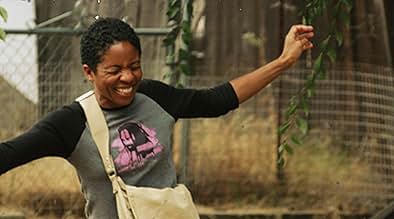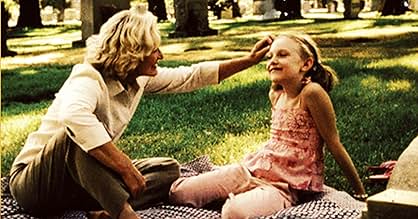Presas das próprias relações que as definem e as sustentam, nove mulheres enfrentam as provações e decepções da vida com resiliência.Presas das próprias relações que as definem e as sustentam, nove mulheres enfrentam as provações e decepções da vida com resiliência.Presas das próprias relações que as definem e as sustentam, nove mulheres enfrentam as provações e decepções da vida com resiliência.
- Prêmios
- 9 vitórias e 10 indicações no total
- Diana
- (as Robin Wright Penn)
Avaliações em destaque
Ostensibly, the film is collection of 9 short stories or vignettes of 9 different women. In the first four, some characters appear in other episodes. The last five are connected by the word "connection". The last of the nine remains the most difficult and intriguing and an appropriate one to end the film.
The film captures each of the nine segments in a single shot without a cut. The film resembles various works of Robert Altman--even the long-shot of "The Player"--and the structure of "Magnolia" and "Crash." What "Nine Lives" has that the others do not is the Marquezian element of magical realism.
To explain this one has to begin at the final episode. "Nine lives" alludes to the cat. A cat is shown on a gravestone. A mother (old enough to be a grandmother) escorts a young girl (her daughter) to a grave and brings with her not flowers, but a bunch of grapes. She leaves the grapes behind on the grave. The final shot does not show the girl but the mother alone. Whose grave is it? Is the young girl real (or alive)? Did the mother bring grapes for a child who loved grapes, who is now merely a memory for an old woman? The stories are interconnected by relationships (mother-child) episode 1 and 9, parents and children (2 episodes of Holly and Samantha), husband and wife (Camille) and the trio of husband, wife and lover (Diana, Lorna and Ruth).
To savor the richness of the film, one has to go beyond each segment and look at the links the director provides to see the breaks in relationships and the ultimate reconciliation the full film provides. In the first episode, the viewer sees a break in the relationships. In the finale there is reconciliation even in death. In between, divorced couples consent to sex, a young teenager appears to be more sensible than her quarreling parents by giving up a chance for better education to keep the fragile family together, and another fighting couple remind you of Albee's George and Martha in "Who's Afraid of Virginia Woolf?" An abused daughter realizes she cannot kill her father. A faithful husband helps his wife get emotionally ready for a mastectomy.
If there is a flaw, you can point out that it looks at nine women rather than nine men. But then in literature, cats are associated with females rather than men, and the director was born to a family who appreciated literature.
There is little that is spoken in this film. But each word is important to understand and enjoy the film. It is a film that deserved the Locarno Film festival honors. Personally, I loved the performances of Glen Close, Robin Wright Penn, the lovely Amanda Seyfried, Elpida Carillo and Ian McShane. But the entire cast was great--like any Altman film. Garcia, unlike Altman, stresses on the spoken word, not merely the images and music.
I saw the film at the recently concluded Dubai Film Festival. Was it a coincidence that Marquez's friend and Chilean filmmaker of repute--Miguel Littin--was outside the cinema hall trying to get a feel of the reaction of the audience to film made by his friend's son without being noticed?
Writer/director Rodrigo García creates nine vignettes, each introduced by the central character's name like a chapter heading, as master acting classes. In about ten minutes, each actress, and occasionally their male supporters, go from zero to ten, less through the language, which is so natural it seems improvised, but through their faces, bodies and inflections.
Each woman faces an emotional crisis involving her relationship with a loved one -- parent, child, lover, husband, sister; sometimes the stories start them at a high point and they reach a catharsis, others are in the midst of a normal day and then get socked with interactions that rock their balance. Each tries to stay in control of their situations, with emotional prices to pay. About half the characters briefly cross-appear in stories that may come before their previous appearance, mostly to add ironic meanings to a situation or dialog that would have a different impact without the added information from the other vignette. A refrain of "I can't stop thinking about you" comes with different meanings about love and guilt or obsession each time, though this is more about connections between people (as symbolized by the webs behind the interstitial name cards).
The two hander with Robin Wright Penn and Jason Isaacs (with a very creditable American accent, though he seemed to be playing a very similar character as he did on "West Wing") packs a wallop, mostly through Penn's expressions and complete body language, from her eyelids to her fingers to her feet. A shopping walk through the long aisles of your neighborhood supermarket may never have quite the same expectations. Garcia's gliding camera work adds to the emotional freight as by widening and lengthening the frame he gradually reveals more information about the two characters.
Amy Brenneman paying respects at a funeral builds up in nervousness as we learn more about the complicated background of her relationship with the deceased, then goes for a crescendo in a brief, almost silently dynamic interaction with an explosive William Fichtner. This may be the first time that certain American Sign Language words have been used in a movie.
Lisa Gay Hamilton's character is so emotionally wrought that you get agitated just watching her, even as we cry over why she's so radioactive.
Kathy Baker facing surgery reveals more of the emotional complications for couples facing medical issues than a dozen Lifetime TV movies.
Garcia well shows women caught between strong people, particularly the vignettes with Amanda Seyfried and Holly Hunter, though the latter recalls "Who's Afraid of Virginia Woolf?" too much. Molly Parker creates warm chemistry with women as a friend in two stories. Dakota Fanning actually acts her age and seems like a natural child for a change in her vignette with Glenn Close.
I presume this was shot on digital video, judging by the saturated look of the beautiful cinematography. What will be lost by waiting to see the film on DVD will be the subtle details of the actresses' fulfilling performances that should be seen on a big screen.
The main problem with a movie like "Nine Lives" is that, for all the insights it offers into life and human relationships (and they are many), it simply can't develop its characters to any appreciable extent in the time it has allotted them. Just as we are becoming engaged by a particular woman and her situation, the movie shuts us down by cutting away to the next segment. This is really no criticism of the movie per se - which is a well written, well acted and well directed piece of lyrical film-making - but the structure dilutes our interest and robs the film of the cumulative force it might have had were the individual stories fleshed out to feature length.
Still, given the limitations, this is a film filled with flavorful moments and fine performances from a large and gifted cast that includes Sissy Spacek, Mary Kay Place, Glenn Close, Dakota Fanning, Holly Hunter, Lisa Gay Hamilton, Robin Wright Penn, Joe Mantegna and Aiden Quinn, among many others. And the final moments are so tender, poignant and touching that they carry the film to a level where it transcends artifice and makes a genuine human connection with its audience. Thus, despite the reservations one might have about the film as a whole, the parts are more than compelling enough to make it well worth watching.
Você sabia?
- CuriosidadesWhile the film was largely overlooked by moviegoers, critical reaction was generally favorable and both Roger Ebert and Richard Roeper included it on the year end top 10 lists.
- Erros de gravaçãoIn the "Sonia" chapter a camera mans arm is visible in the mirror on the floor in the living room.
- Citações
Lorna: What? I don't want to be here with you.
Andrew: I can't stop thinking of you.
Lorna: Andrew.
Andrew: I can't.
Lorna: Andrew, your wife's funeral's in here.
Andrew: She's not my wife. You're my wife. I married her because you left.
Lorna: I have an idea. Why don't you and I make out in front of her dead body? It would excite you, huh?
Andrew: This has nothing to do with her.
Lorna: You don't think so? You don't think this is her day?
Andrew: She's dead now! She doesn't have to worry now!
Lorna: You shit, you've gone crazy.
Andrew: No I haven't.
[tries to touch her]
Andrew: I masturbate thinking about you.
[Lorna turns and walks in the room]
Andrew: That time in the car - in Santa Cruz... You drove me crazy. Nobody can make me come like that. Only you can do that.
[approaching her]
Andrew: Do you think about me? Tell me! Tell me if you think about me sometimes!
[looks her in this eyes, closely]
Andrew: If you don't, I'll get out of here right now.
Lorna: Did she know about this?
[Andrew kisses Lorna]
- ConexõesFeatured in Siskel & Ebert & the Movies: The Best Films of 2005 (2005)
- Trilhas sonorasMemories
Written by Francois Paterson, Dominic Paterson and Christelle Pechin
Performed by Soma Sonic
Courtesy of Subsonic Recordings
Principais escolhas
- How long is Nine Lives?Fornecido pela Alexa
Detalhes
- Data de lançamento
- Países de origem
- Centrais de atendimento oficiais
- Idiomas
- Também conhecido como
- Nove Vidas
- Locações de filme
- Empresas de produção
- Consulte mais créditos da empresa na IMDbPro
Bilheteria
- Orçamento
- US$ 500.000 (estimativa)
- Faturamento bruto nos EUA e Canadá
- US$ 478.830
- Fim de semana de estreia nos EUA e Canadá
- US$ 28.387
- 16 de out. de 2005
- Faturamento bruto mundial
- US$ 1.591.523
- Tempo de duração1 hora 55 minutos
- Cor
- Mixagem de som
- Proporção
- 1.85 : 1
Contribua para esta página










































